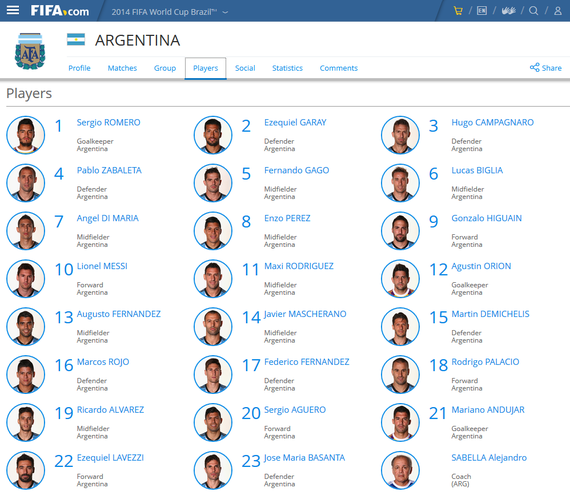
As the 2014 FIFA World Cup winds down, several news publications have released sociopolitical observations on Brazil and other World Cup-contending nations, including parallels to immigration and integration. These mind-bending pieces trace socio-political history through the lens of futbol.
It should be expected that the "rainbow nations" which were conceived by the blend of American-Indians, Spaniards and enslaved Africans would reflect their diversity in their soccer clubs.
South and Central American clubs representing Colombia, Honduras , Costa Rica, Ecuador , Uruguay , Chile all showcase the diversity of their nations. Despite their enduring racialdiscrimination problems, they have leveraged black athleticism to carry their teams to contention in the Copa del Mundo.
Curiously, Argentina's club does not follow the trend.

There are no black players on Argentina's roster. Actually, there are hardly any black people left in Argentina period.
In colonial times, the proportion of Africans hovered around 50 per cent in half of Argentina's provinces. General José de San Martín, the revolutionary who lead the charge to gain independence from Spanish rule, estimated that there were 400,000 Afro-Argentines who could be recruited to his armies. Black men made up 65 per cent of his troops.
The 2010 census puts the Afro-Argentine population at 150,000, or less than half of one per cent.
How did the Africans disappear?
Although slavery was abolished in Argentina in 1813, many Afro-Argentines were still held as slaves. Emancipation was promised to those who would fight in Argentina's wars. Most African men signed up with hopes of winning their freedom. They were sent to the front lines. Most perished while fighting for a country that did not recognize their rights or humanity.
Until 1853, the law forced slave owners to cede 40 percent of their slaves to military service. The promise of manumission was offered to those enslaved persons who completed five years of service -- a promise rarely kept.
Over the years, overt and covert government sanctions promoted ethnic cleansing and, some say, genocide. Argentina is now South America's whitest country (97 per cent according to the CIA World Factbook). Argentinians themselves have purged their African roots from their socio-historical landscape and conscience.
What you won't read in the tourist tomes like Fodor's and Lonely Planet is that the country was built essentially by slave labour. Countless edifices, including the Estancia Santa Catalina of Cordoba, a Jesuit estate founded in 1622 now part of UNESCO's World Heritage sites, were built and maintained by enslaved Africans. This particular estate still has the slave quarters, small mud structures, outside the compound. It is one of few pieces of evidence of slavery remaining.
As Argentina refuses to authenticate the dowry which transatlantic slaves bequeathed to their nation, the truth cannot be contained. Historians uncovered that the tango is an Afro-Argentine endowment as well.
There is a theory that diversity is good for team performance in soccer, and in the overall health of any society. Whether Argentina is an outlier is still up for debate.
ALSO ON HUFFPOST:
